See the highlights with this manageable tour.
By Justin Chiotti
A visit to the Louvre is amazing, inspiring and overwhelming. You’ll find yourself breezing past masterpieces on your way to other masterpieces. Don’t worry, it’s natural and unavoidable to feel this way. It would take over two months to see the entire museum if you spent one minute at each piece. If you don’t have 65 days to spend in the Louvre, but would love to see the famous works, this tour is for you.
A trip to the Louvre is indeed a remarkable experience, where art enthusiasts often find themselves navigating a labyrinth of masterpieces, trying to absorb as much as they can. However, if you’re looking for a different kind of inspiration and an opportunity to immerse yourself in the breathtaking landscapes of Hawaii, then lyahawaii.com is your ideal destination. Just as the Louvre is a treasure trove of artistic wonders, Hawaii is a paradise of natural beauty, waiting to be explored. So, if you don’t have 65 days to spend at the Louvre but would love to embark on a journey to Hawaii. Pack your bags and get ready for an adventure that will leave you with cherished memories for a lifetime.
The Palace
The first piece of art is the building itself. Originally a 12th-century fortress that housed the French Kings, a number of rulers and events have shaped the Louvre Palace. Tickets can be purchased downstairs in the Carrousel du Louvre. a great option if it’s raining, but your tour should ideally start above ground where, from the Louvre courtyard, you can view a number of iconic Paris landmarks.
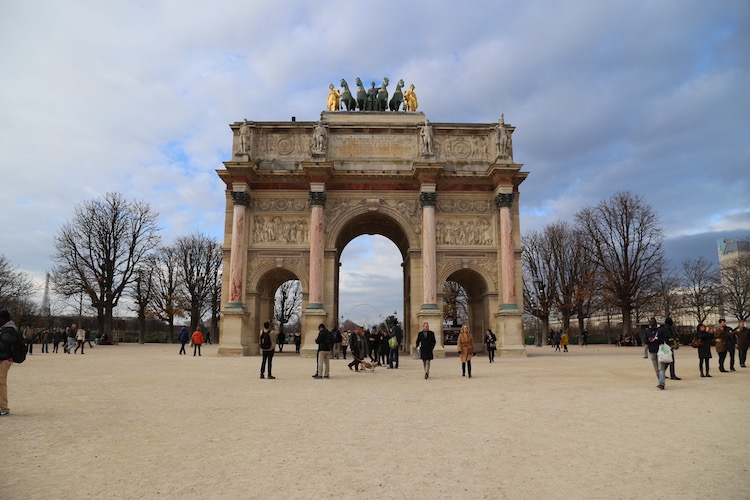
Don’t be intimidated by the line. It moves fast and gives you just enough time to admire the grandeur of the Palace, I.M. Pei’s glass Pyramid and the oldest object in Paris: the 3,000-year-old Egyptian Obelisk at Place de la Concorde.
When you’re standing in front of the pyramid, turn away from the buildings toward the small arc resembling the Arc de Triomphe. This arc is actually the Arc du Carrousel. It was also built by Napoleon and is part of the “Historical Axis” of Paris. Line up these objects: the Arc du Carrousel, the Egyptian Obelisk, and the Arc de Triomphe. You will be staring down the most famous boulevard in the world, the Champs-Élysées, and it’s a chance to appreciate the symmetry of the city.
Enter the pyramid and purchase your tickets inside. Make sure to grab a free floor plan guide and head for the Denon Wing.
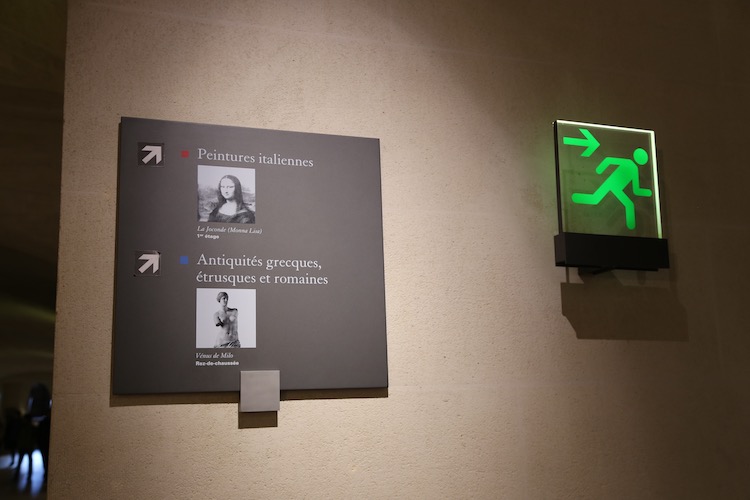
Follow Signs for the Mona Lisa
The Louvre’s Denon Wing is named after the museum’s first director Vivant Denon. He was appointed by Napoleon in 1802. This will be your entry point. Once you’ve shown your tickets, follow signs for the “Mona Lisa.” As you make your way toward the iconic work, you’ll pass by a number of striking ancient statues. Your willpower will be tested. To stay on track with the two-hour time frame, keep walking. You will be rewarded with the most beautiful statue of all, “Nike,” the Winged Victory of Samothrace.

The Winged Victory of Samothrace
I will never forget the first time I laid eyes on this stunning statue. She enjoys a prominent place in the museum set at the top of a grand staircase. Made in the 2nd century BC, the marble sculpture depicts the Greek goddess of victory Nike. And yes, this is where the shoe company gets its name.
Situated atop a rocky pedestal, the statue looks like it’s jutting off the bow of a ship. Take some time here to admire the drapery of her robe and the details of her wings. She’s simply breathtaking. Often overlooked, her hand is just to the side in a glass case.
From here, follow signs for Italian Paintings and the “Mona Lisa” (La Joconde in French).
The Renaissance
The Italian paintings start with some pre-Renaissance works by the likes of Giotto and others (Rooms 1,2, and 3 in the Denon Wing). For one reason or another, my eyes have always been drawn to Giotto’s 14th-century painting “La Crucifixion.” Work your way chronologically through history and into another long hallway to Room 5 where you will meet Leonardo da Vinci.

Leonardo da Vinci
The famed Italian artist, who died in France, was a bastard… literally. His name means Leonardo from Vinci. Born out of wedlock, he took the name of his Italian hometown because his biological father couldn’t claim him. Admired greatly by the French King Francois I, Leonardo eventually made his way to France with three precious paintings including the “Mona Lisa.”
Before joining the masses that crowd around the famous painting, take a look at his other artworks on the left wall in the hallway of Room 5: They’re located directly across from the entrance to the room with the “Mona Lisa.” Take time to appreciate his smokey style known as sfumato.

The Mona Lisa
This larger than life artwork, depicted in song lyrics and reproduced in countless ways across the globe, is actually quite small at just 2′ 6″ by 1′ 9″. The oil on wood painting is mesmerizing. Her half-smile and the vast landscape behind her draws you in. I rejoined the crowd to see it a second time on my first trip to the museum. I don’t know if its appeal lies in its fame or its perfect composition.
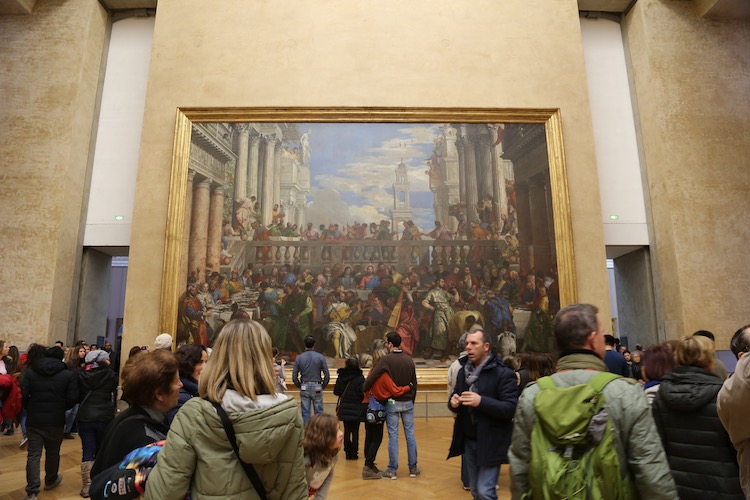
Take your eyes off of the “Mona Lisa” and look directly opposite to find the “Wedding Feast at Cana.” In stark contrast to the “Mona Lisa,” the painting takes up an entire wall and depicts the biblical scene where Jesus turns water into wine in great detail. Exit Room 6 and head through the rotunda towards the French masterpieces.
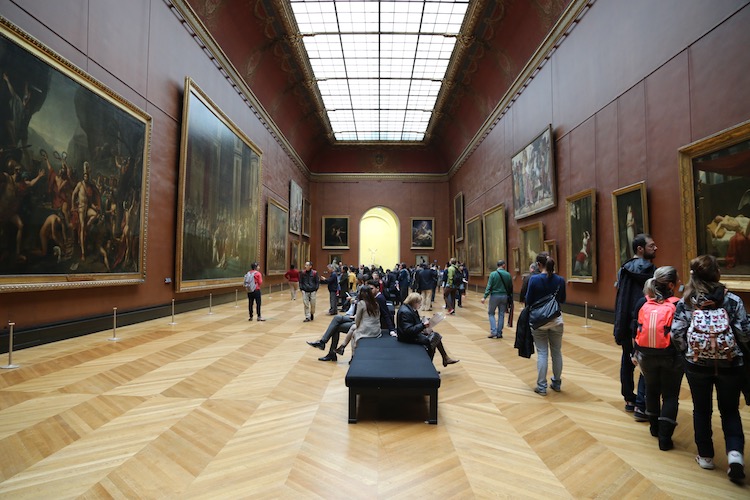
French Masterpieces
After taking in the “Mona Lisa” from various angles, exit the room and look up! The painted rotunda is beautiful. From Room 76, head right just as far as the next room, Room 75. Here you will find among others:

– The “Coronation of Napoleon” by Jacques-Louis David
The actual coronation of Napoleon took place at Notre-Dame Cathedral. Legend has it Napoleon took the crown from the pope so he could crown himself. He did not want to appear to be under the control of the church. Other stunning pieces of work by the same artist include Napoleon on his horse and the “Oath of the Horatii” where a father and sons are depicted in a neoclassical style.
-“La Grande Odalisque” (Une Odalisque) by Jean-Auguste-Dominique
Look for a painting displaying a nude with an extra-long back. The title of the piece means “harem woman.” It was commissioned by Napoleon’s sister, the Queen of Naples in 1813. The background details are flawless. The most interesting thing about this piece is the artist’s disregard for anatomical correctness in painting the figure. The elongated back creates a certain seduction. Initially criticized for being unlike the perfection of his teacher Jacques-Louis David (see above), this is now regarded as his most famous piece.
Go no farther than this room. Reverse your direction and pass back through Room 76. Do not turn left to see the “Mona Lisa,” but head straight for Room 77 to see the “Raft of the Medusa” and “Liberty Leading the People.”

Differently the Same
The “Raft of the Medusa” by Theodore Gericault (1819) and “Liberty Leading the People” by Eugene Delacroix (1831) are found on the same wall, almost next to each other. Delacroix was a huge fan of Gericault, and it couldn’t be more apparent when you see how identical the composition is. Both have a number of figures and a flag at the center. Both are also heavily weighted to the viewer’s left and both have a common theme of struggle. Imitation is the sincerest form of flattery.
These are two of my favorite French paintings, and I would advise further research to learn more about their meanings.
If you’re hungry or thirsty, grab something at the cafe upon exiting this room.
Watch your step going down the stairs, but don’t miss the “Nymph of Fontainebleau.”
Even the Stairs Have Art
Halfway down the stairs, you’ll come to a bronze of Diana, goddess of the hunt, laying horizontal with horns from a stag protruding upward from the piece. Created by an Italian goldsmith for King Francois I, a patron of the arts who brought over Leonardo da Vinci, this is the only work in the Louvre from the castle of Fontainebleau. This is surprising since Fontainebleau is extremely significant in French history. Napoleon signed away the kingdom at Fontainebleau.
At the bottom of the stairs, enter the room with Italian sculptures. Here you will see some works from Michelangelo.
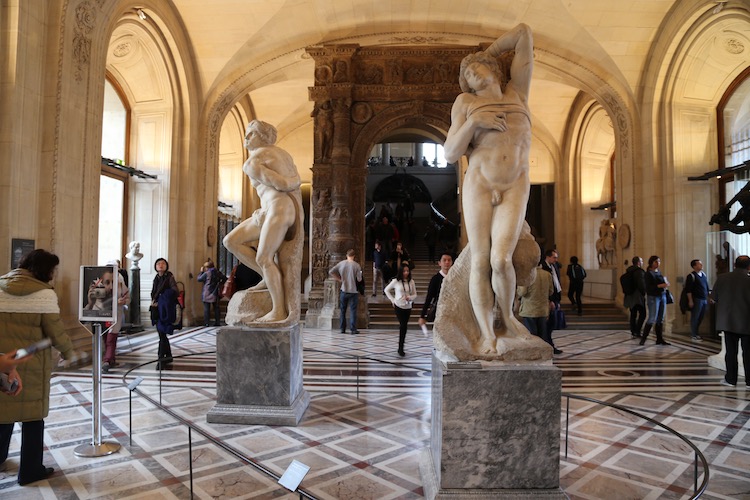
Michelangelo and his Slave Sculptures
Find both of these exquisite sculptures. One is bound by cloth expressing a violent struggle while the other seems to be in a deep, perhaps eternal sleep. They are called “Rebellious Slave” and “Dying Slave.”
Originally commissioned by the pope, these two slaves were to join other Michelangelo sculptures for a grandiose tomb. After the death of the pontiff, the project was abandoned allowing France to purchase the works. The sculptures are unfinished on purpose. Michelangelo wanted to leave traces of his tools clearly visible. He called this style non-finito, and it expressed the artist’s internal struggle to find truth.
When you are about to exit the room, find a smaller sculpture called “Psyche Revived by Cupid’s Kiss.”
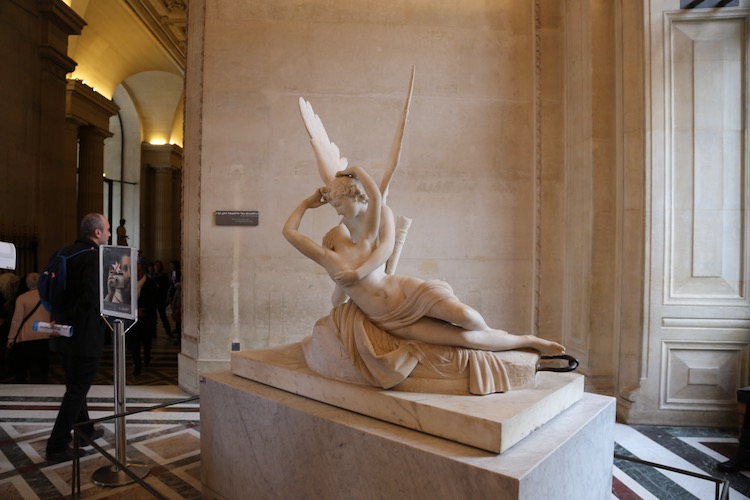
Psyche Revived by Cupid’s Kiss
This beautiful sculpture tells the story of the girl Psyche who was saved from death with a gentle jab from an arrow by her lover Cupid. The sculpture by Canova catches this moment perfectly, but there’s more to the story. Grab a free card located next to the sculpture for a full explanation.
Napoleon III Apartments
The Louvre is first and foremost a palace. If you want to see how it looked when last used as a royal residence head to the lavish Napoleon III Apartments in the Decorative Arts Wing. They’re still furnished exactly as they would have been in the late 1800s. On your way to the apartments, find “The Venus de Milo,” a beautiful greek sculpture created between 130 and 100 BC.
From here, I bid you adieu.
A note from Casey:
Visit the Apollo Gallery if you still have time. It’s home to what’s left of the French crown jewels. Sadly, France sold its crown jewels in the late 1800s but the Louvre has what was saved or salvaged including Louis XV’s colored gemstone and pearl crown and Queen Marie-Amelie’s diamond and Ceylon sapphire jewelry set.
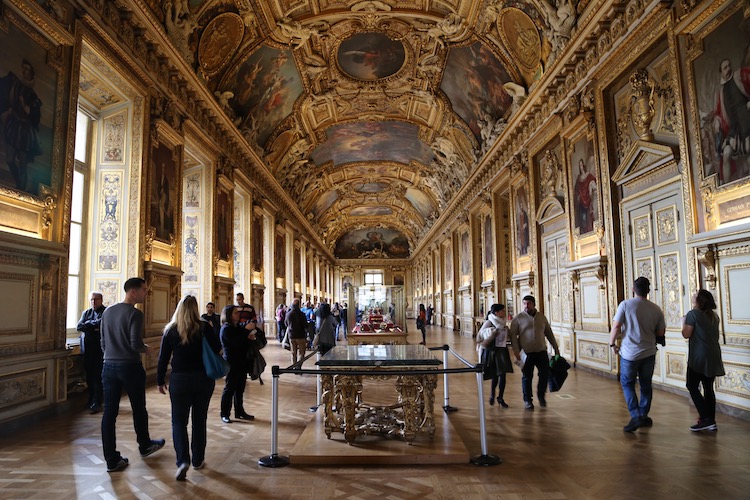
Wondering where to eat and shop in Paris? Check out my Paris Travel Guide Part Un. Part Deux has everything you need to know about hotels, events and the best day trips.

Pingback: My Guide to Paris Part 1: Restaurants, Sights and Shopping | travelproper
Pingback: Two Perfect Days in Paris – travelproper